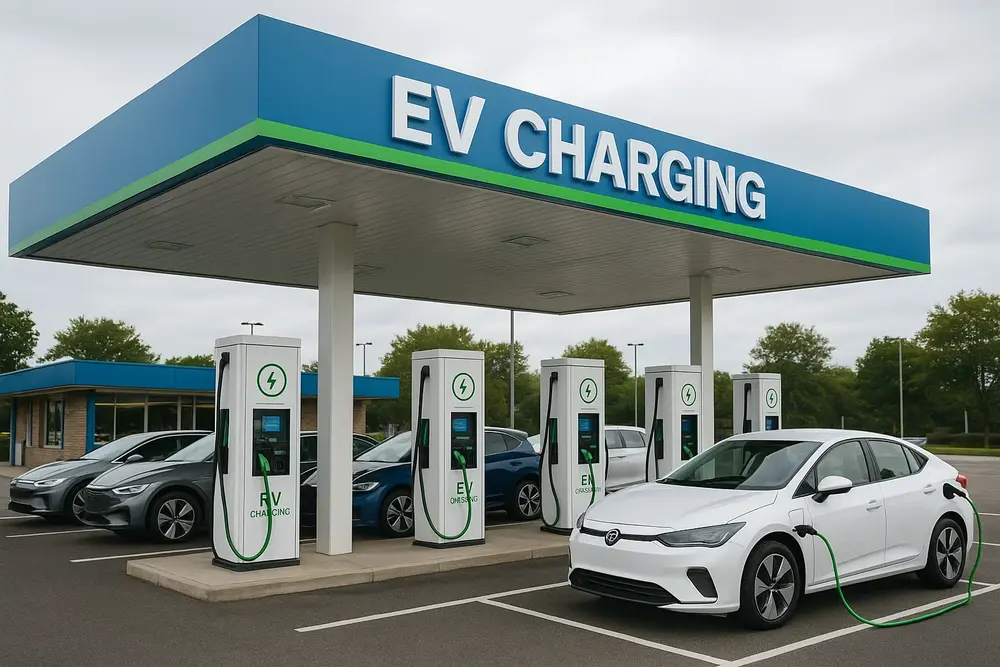
Products
Fast, Reliable, Everywhere

Solutions
Efficient, Innovative EV Charging Solutions.
News
We are committed to the innovation and application of EV charging.
Modern gas stations have evolved far beyond simple fuel stops. Today’s customers expect much more—from grabbing a fresh coffee or snack to using restrooms, restocking groceries, or enjoying quick convenience services.
As electric vehicles (EVs) gain popularity globally, fuel station operators have a unique opportunity to stay ahead of the curve by integrating EV charging infrastructure. By doing so, you can attract a broader, tech-savvy customer base and secure your place in the future of sustainable transportation.

The number of EVs on the road continues to grow at an exponential rate, creating a pressing need for reliable, high-speed charging stations, especially along major travel corridors. Fuel stations are strategically positioned to meet this need, thanks to their established locations and customer service offerings.
But many station owners are still hesitant—often citing cost, complexity, or uncertainty about return on investment. In reality, adding EV charging stations can be one of the most strategic upgrades for your location.
It might seem counterintuitive—EVs don’t require gas, so why would EV owners visit fuel stations? However, surveys show that nearly 30% of EV users in Europe already charge at gas stations, and over 20% would like to if the service was available.
Unlike slow AC home chargers, DC fast charging stations can recharge a vehicle in just 15–45 minutes. When drivers are on road trips, commuting, or lacking private parking, fast public charging becomes essential—and gas stations are often the most accessible option along the route.
Unlike traditional fueling, EV charging habits resemble smartphone charging behavior. Most drivers prefer to “top up” frequently rather than wait until the battery is nearly empty.
This means offering charging even when it's not urgently needed can still attract users. If your gas station has visible, accessible EV chargers, many EV drivers will stop for a quick charge, especially if they’re already stopping for coffee, restrooms, or snacks.
One of the most overlooked benefits of installing EV charging infrastructure is digital visibility. Charging stations appear on popular navigation apps like:
PlugShare
ChargePoint
Google Maps
Apple Maps
Being listed in these directories can introduce your gas station to entirely new customers who are actively searching for places to charge.
EV chargers don’t just provide a utility—they send a message. A gas station that invests in electric vehicle charging shows it’s committed to innovation, sustainability, and customer service.
With eco-consciousness becoming a key factor in purchasing decisions:
62% of consumers value reducing transport emissions
61% of potential EV buyers associate electric driving with environmental responsibility
Over 75% of global consumers prefer brands that support sustainability
Installing chargers today can elevate your station’s image, attract new demographics, and show long-term commitment to clean energy.
Did you know that nearly 40% of EV owners still own a gas-powered vehicle? Many EV adopters are gradually transitioning and still rely on gasoline for part of their mobility.
This means your current customers might already drive electric—and would happily charge at your location if given the option. And with over 48% of U.S. consumers intending to buy an EV as their next vehicle, the market is rapidly expanding.
Gas stations that offer EV charging are already seeing:
Increased dwell time and foot traffic
New revenue opportunities from upsells
Partnerships with fleet operators and rideshare providers
Improved public perception and community trust
As governments and automakers push for zero-emission goals, public EV charging will become a critical component of transportation infrastructure.
Converting your gas station into an EV-friendly destination is more than a trend—it’s a strategic move to future-proof your business. While there’s an upfront investment, the potential rewards are substantial:
New customer segments
Extended service offerings
Stronger brand positioning
Explore our comprehensive [EV Charging Guide for Fuel Retailers] to discover everything you need to know—from choosing the right chargers to understanding costs, incentives, and installation logistics.